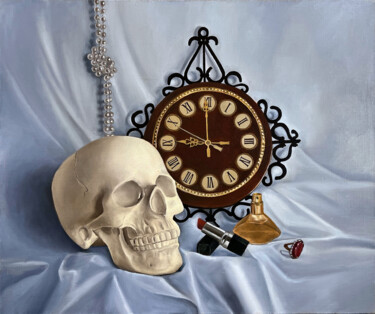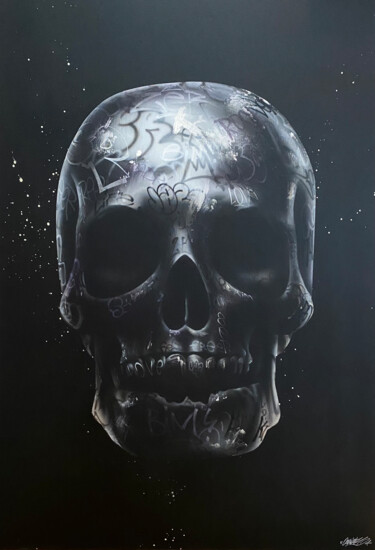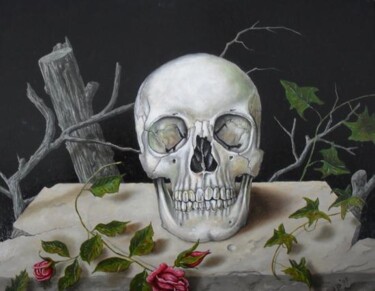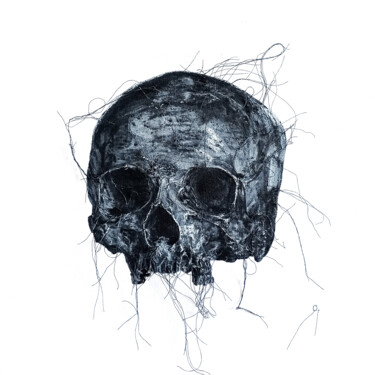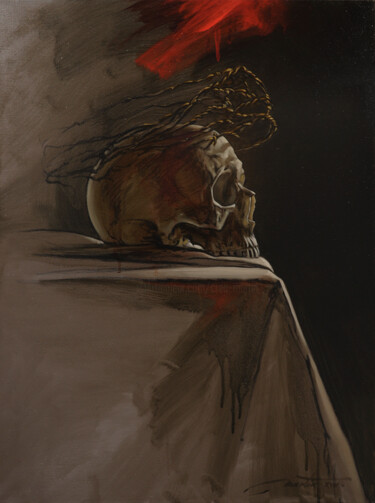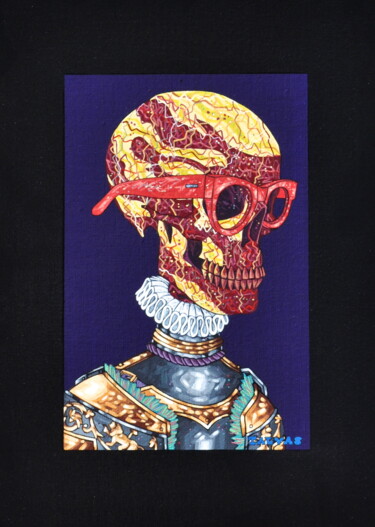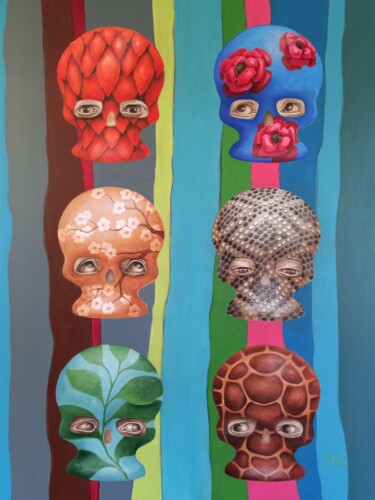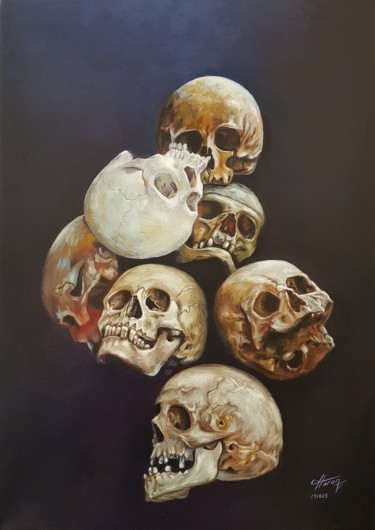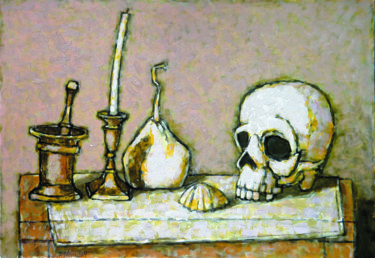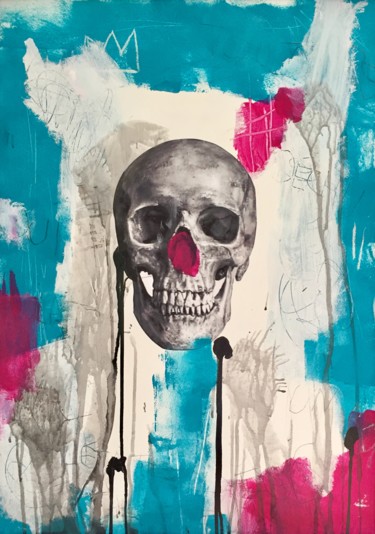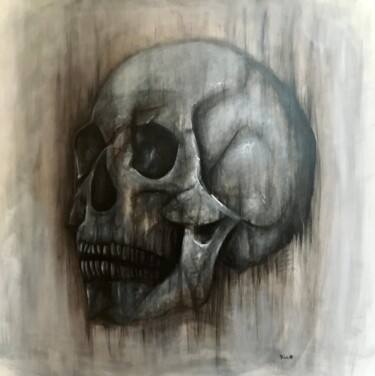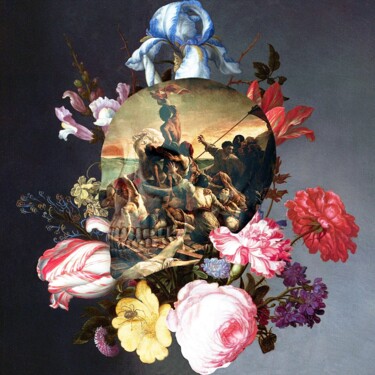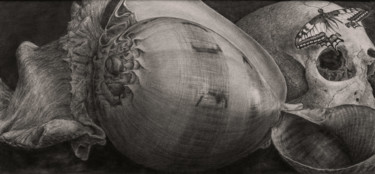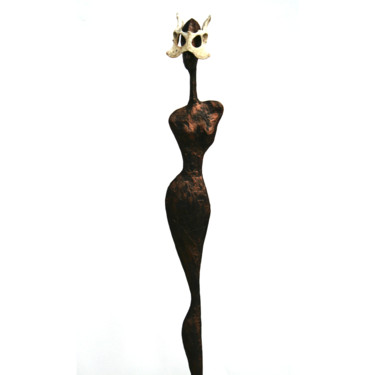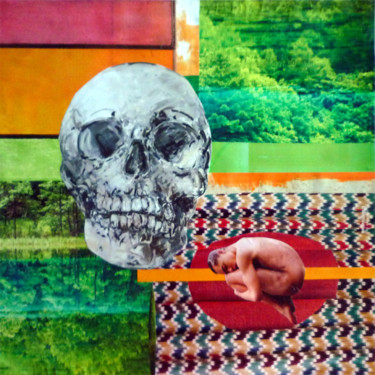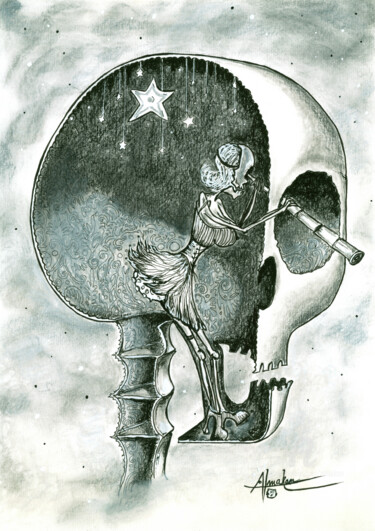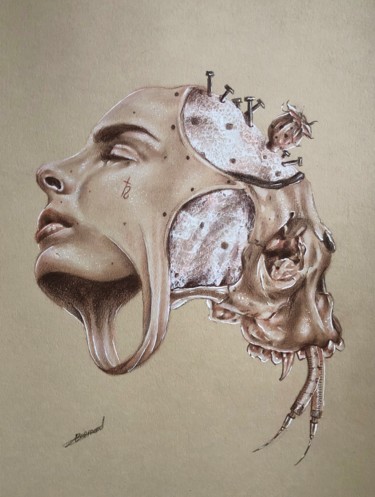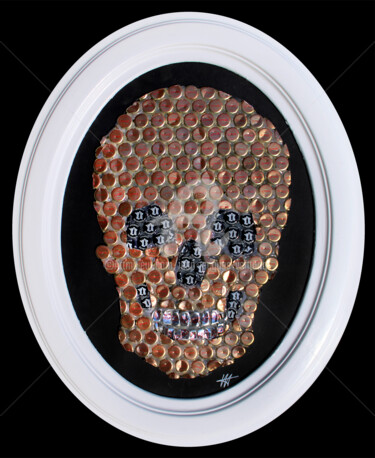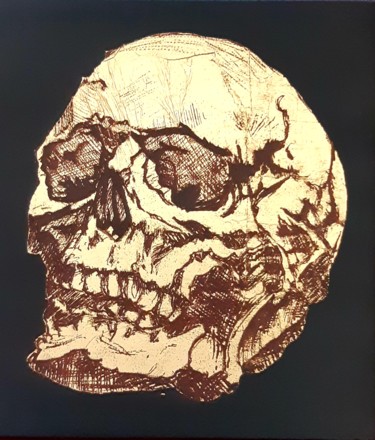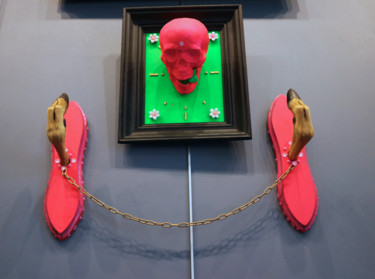 Yann Michael Talvas, Always the sun, 2017. Acrylic on linen canvas, 81 x 65 cm.
Yann Michael Talvas, Always the sun, 2017. Acrylic on linen canvas, 81 x 65 cm.
Vanity: definition and origin of the term
Vanity refers to a specific type of still life, which, through the inclusion of characteristic symbolic objects, such as, for example, skulls, hourglasses and luxury goods, aims to remind the viewer, both of the inexorable passing of time, and the future advent of death, and, consequently, also of the futility of ephemeral earthly goods and pleasures. In fact, the aforementioned Latin term, part of the expression taken from the Bible "vanitas vanitatum," or "vanity of vanities," literally means "caducous," a perfect word to allude to a pictorial iconography with purely moralistic intentions, aimed at inviting viewers to abandon venal pleasures and desires in order to attend to the more important eternal salvation.
 Bart Stillekens, "Boar skull", 2021. Sculpture, resin / metals on object, 30 x 20 x 25 cm / 2.00 kg.
Bart Stillekens, "Boar skull", 2021. Sculpture, resin / metals on object, 30 x 20 x 25 cm / 2.00 kg.  Margarita Ado, Yesterday's dessert, 2021. Oil on linen canvas, 60 x 80 cm.
Margarita Ado, Yesterday's dessert, 2021. Oil on linen canvas, 60 x 80 cm.
Vanity: origins of the pictorial genre
Already in the late Middle Ages, the Church had raised a stern warning, reminding how riches accumulated on earth, besides having no value, led to eternal damnation. Therefore, it was during this period that the first pictorial depictions in which luxury goods were accompanied by skulls originated. Such depictions intensified, however, during the seventeenth century, and, especially, in the era following the Thirty Years' War, a time frame in which wartime conflicts, epidemics, the economic crisis following the discovery of America, religious schism, and the disarray brought about by the Protestant Reformation, put humankind in serious crisis. Consequently, in the artistic landscape of seventeenth-century Western art, the need for works capable of conveying an awareness of the dramas of man, whose precarious existence, made him, oftentimes, "a victim" of a fate that was too often cruel, was strongly grafted on. Despite this widespread crisis, however, the vanity genre found greater success in northern Europe, where Protestantism fostered the spread of works of art designed to instill individual reflection on God. In particular, the country where this type of still life was most successful was Holland, where vanity spread between the 16th and 17th centuries, also affecting the work of the best-known Flemish masters.
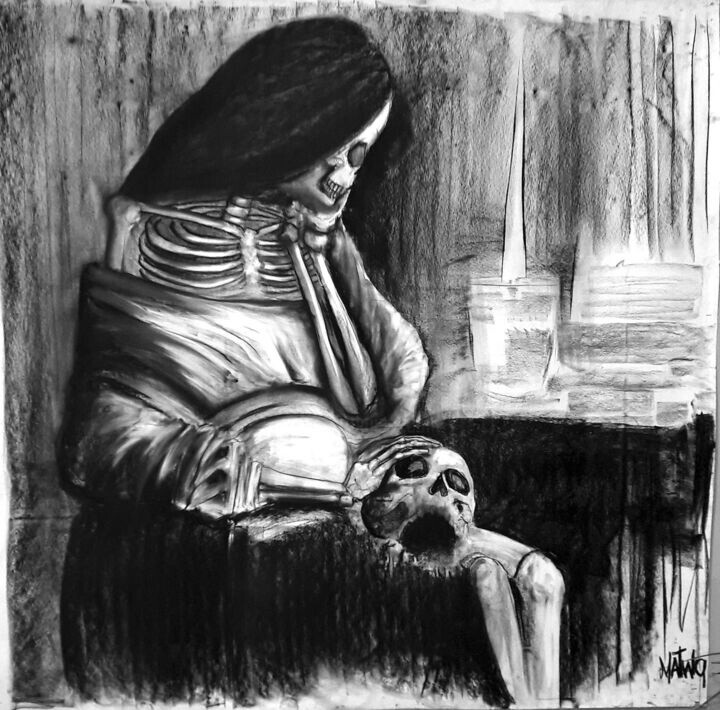 Yannick Duriez, Lamadeleine at the night light, 2018. Charcoal on paper, 150 x 150 cm.
Yannick Duriez, Lamadeleine at the night light, 2018. Charcoal on paper, 150 x 150 cm.
 Rai Escale, Skully, 2017. Acrylic on other medium, 118 x 59 cm.
Rai Escale, Skully, 2017. Acrylic on other medium, 118 x 59 cm.
Vanity: symbolism, composition and style
The memento mori of vanity is generally communicated through a "standard" figurative "code" involving the juxtaposition, or choice, of three possible types of objects/themes:
- gold, jewelry and the like, which allude to wealth;
- books, maps and pens, personification of knowledge;
- food, wine and rich fabrics, symbols of pleasures.
These subjects necessarily accompany the depictions of skulls, but also of candles, withered flowers, clocks and hourglasses, the fundamental subjects of the composition, aimed at highlighting the futility of earthly things, in the face of the only certainty of life, namely: the transience of time and, consequently, death. Moreover, despite the fact that the works of the genre are often very rich in objects, it is precisely through this "chaotic" crowding, that a very conscious stylistic, and symbolic choice, aimed at giving voice to profound concepts, often materializes. It is precisely this latter aspect that distinguishes vanity from traditional still lifes, which are conceived essentially to showcase the painterly skill of the creator, rather than with the intention of preaching principles of impact. Moreover, for the very purpose of realizing the latter purpose, vanity adopts a purely realist point of view, since only relevance to the real datum can guide the viewer to "heaven" through the contemplation of earthly objects.
 Odile Guichard, Vanity 01, 2022. Acrylic / embroidery on canvas, 40 x 40 cm.
Odile Guichard, Vanity 01, 2022. Acrylic / embroidery on canvas, 40 x 40 cm.
 Paulo Vilarinho, Vanitas II, 2018. Photomontage / digital painting on paper, 44 x 44 cm.
Paulo Vilarinho, Vanitas II, 2018. Photomontage / digital painting on paper, 44 x 44 cm.
Artmajeur artists' vanity
Vanity, widely popular during the 16th and 17th centuries, has also influenced the work of great contemporary masters, including, Andy Warhol, Graciela Iturbide, Kang, Young Min and Damien Hirst, authors of iconic skulls aimed at carrying forward the same concept of memento mori. In addition to the "members" of the great art tradition, Artmajeur's artists have also dabbled in giving novel interpretations to the said genre, carrying forward the more traditional cautionary message in order to adapt it to our times. Exemplifying this contemporary type of still life, often reduced to the mere depiction of skulls, is the work of Didier Lannoy, Jean-Marie Gitard (Mr. STRANGE) and Tom Schaer.
 Didier Lannoy, $kull Vuitton, 2022. Sculpture, resin on wood, 15 x 12 x 10 cm / 1.00 kg.
Didier Lannoy, $kull Vuitton, 2022. Sculpture, resin on wood, 15 x 12 x 10 cm / 1.00 kg.
Didier Lannoy: $kull vuitton
Didier Lannoy's resin and wood sculpture depicts a luxurious skull, as its carefully crafted surface bears, as indicated by the work's title, the logo of a famous French fashion brand. Thus, the typical vanity theme, aimed at juxtaposing earthly pleasures with the warning of death, seems to have been amply respected by the Artmajeur artist, whose eerie and sumptuous skull seems almost to ask the viewer: will you need Vuitton's glitz on your last journey? We can ask the same question, purely in keeping with the memento mori of vanity, when we also look at For the love of gold, a skull-shaped sculpture by Damien Hirst, intended to be an authentic reminder of the viewer's mortality. Indeed, the surface of For the love of gold, made from the cast of the skull of a European man of about 30 years of age, who, having lived between 1720 and 1810, was purchased by the whimsical British artist from a junk dealer, is covered with 8'601 "useless" diamonds.
 Jean-Marie Gitard (Mr STRANGE), Fragmented death, 2021. Photomontage on paper, 50 x 50 cm.
Jean-Marie Gitard (Mr STRANGE), Fragmented death, 2021. Photomontage on paper, 50 x 50 cm.
Jean-Marie Gitard (Mr STRANGE): Fragmented death
Fragmented death is an intense photomontage on paper, aimed at capturing, through a kind of blurring of the image, the profile of a human skull. Probably, the artist's intent is to make the viewer "mirror" himself in the protagonist of his work, in order to make him realize how, over the years, his current appearance will be changed. In addition, such photomontage is reminiscent, in part, of some close-ups of photographic skull portraits by Alexander de Cadenet, a well-known contemporary British artist, who first exhibited this kind of work in 1996, at The Mark gallery in London. Subsequently, and more precisely between 1996 and 2016, the artist presented additional related works, which, surely inspired by the vanity tradition, pursued the intention of exploring a timeless, and thus skeletal, representation of the human being.
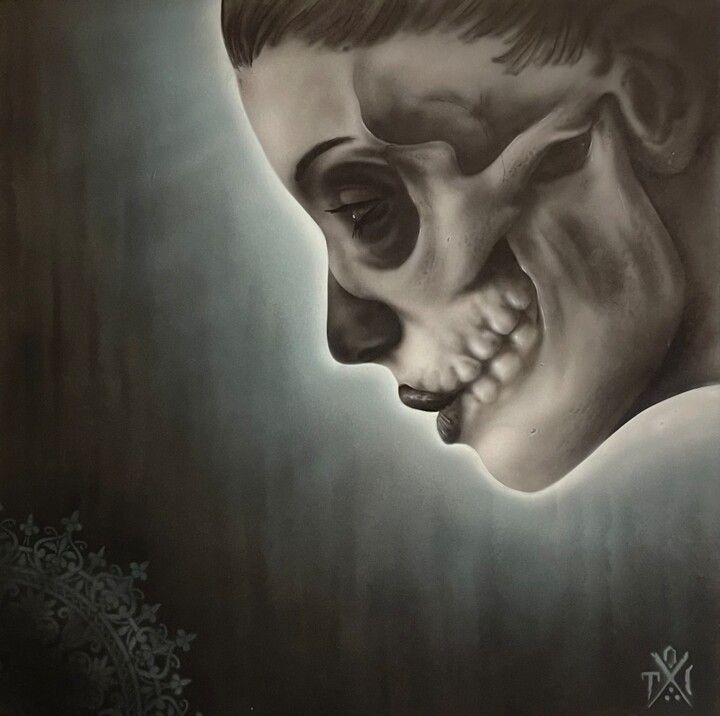 Tom Schaer, Skull woman, 2021. Painting, airbrush / acrylic on wood, 60 x 60 cm.
Tom Schaer, Skull woman, 2021. Painting, airbrush / acrylic on wood, 60 x 60 cm.
Tom Schaer: Skull woman
Tom Schaer's painting, entitled Skull woman, unites the concepts of life and death in one subject, as it captures the close-up of female face that, literally pervaded by the signs of time, is, little by little, turning into a skeleton. Probably, this very personal interpretation of vanity, pursues the intent to remind us that death, an inescapable part of existence, is a silent enemy always lurking. Moreover, it is good to make known how, such juxtaposition of the image of woman with the concept of vanity, also distinguishes a masterpiece of art history, namely All is Vanity by Charles Allan Gilbert. In fact, this very ambiguous work can be seen, either as a woman looking at her reflection in a mirror, or as a skull, intended to remind us of how beauty, health and wealth do not last forever...

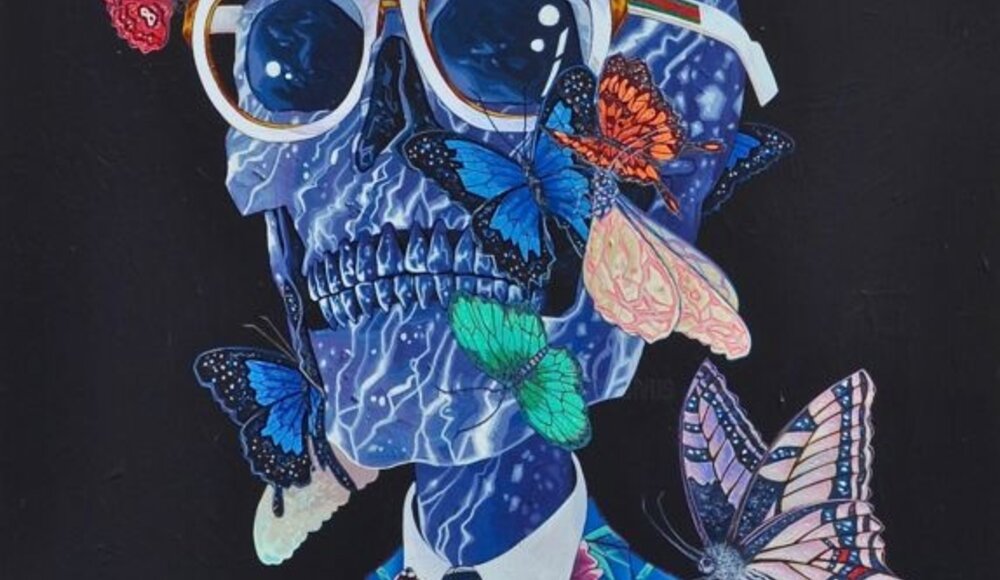
 Olimpia Gaia Martinelli
Olimpia Gaia Martinelli
